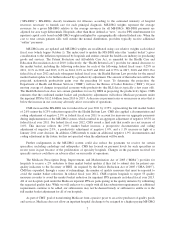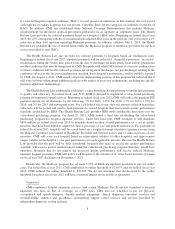HCA Holdings 2011 Annual Report Download - page 20
Download and view the complete annual report
Please find page 20 of the 2011 HCA Holdings annual report below. You can navigate through the pages in the report by either clicking on the pages listed below, or by using the keyword search tool below to find specific information within the annual report.
The following table sets forth certain operating statistics for our health care facilities. Health care facility
operations are subject to certain seasonal fluctuations, including decreases in patient utilization during holiday
periods and increases in the cold weather months. The data set forth in this table includes only those facilities that
are consolidated for financial reporting purposes.
Years Ended December 31,
2011 2010 2009 2008 2007
Number of hospitals at end of period(a) ......... 163 156 155 158 161
Number of freestanding outpatient surgery centers
at end of period(b) ........................ 108 97 97 97 99
Number of licensed beds at end of period(c) ..... 41,594 38,827 38,839 38,504 38,405
Weighted average licensed beds(d) ............. 39,735 38,655 38,825 38,422 39,065
Admissions(e) ............................. 1,620,400 1,554,400 1,556,500 1,541,800 1,552,700
Equivalent admissions(f) ..................... 2,595,900 2,468,400 2,439,000 2,363,600 2,352,400
Average length of stay (days)(g) ............... 4.8 4.8 4.8 4.9 4.9
Average daily census(h) ..................... 21,123 20,523 20,650 20,795 21,049
Occupancy rate(i) .......................... 53% 53% 53% 54% 54%
Emergency room visits(j) .................... 6,143,500 5,706,200 5,593,500 5,246,400 5,116,100
Outpatient surgeries(k) ...................... 799,200 783,600 794,600 797,400 804,900
Inpatient surgeries(l) ........................ 484,500 487,100 494,500 493,100 516,500
(a) Excludes eight facilities in 2010, 2009, 2008 and 2007 that were not consolidated (accounted for using the
equity method) for financial reporting purposes.
(b) Excludes one facility in 2011, nine facilities in 2010 and 2007 and eight facilities in 2009 and 2008 that
were not consolidated (accounted for using the equity method) for financial reporting purposes.
(c) Licensed beds are those beds for which a facility has been granted approval to operate from the applicable
state licensing agency.
(d) Represents the average number of licensed beds, weighted based on periods owned.
(e) Represents the total number of patients admitted to our hospitals and is used by management and certain
investors as a general measure of inpatient volume.
(f) Equivalent admissions are used by management and certain investors as a general measure of combined
inpatient and outpatient volume. Equivalent admissions are computed by multiplying admissions (inpatient
volume) by the sum of gross inpatient revenue and gross outpatient revenue and then dividing the resulting
amount by gross inpatient revenue. The equivalent admissions computation “equates” outpatient revenue to
the volume measure (admissions) used to measure inpatient volume, resulting in a general measure of
combined inpatient and outpatient volume.
(g) Represents the average number of days admitted patients stay in our hospitals.
(h) Represents the average number of patients in our hospital beds each day.
(i) Represents the percentage of hospital licensed beds occupied by patients. Both average daily census and
occupancy rate provide measures of the utilization of inpatient rooms.
(j) Represents the number of patients treated in our emergency rooms.
(k) Represents the number of surgeries performed on patients who were not admitted to our hospitals. Pain
management and endoscopy procedures are not included in outpatient surgeries.
(l) Represents the number of surgeries performed on patients who have been admitted to our hospitals. Pain
management and endoscopy procedures are not included in inpatient surgeries.
17
























